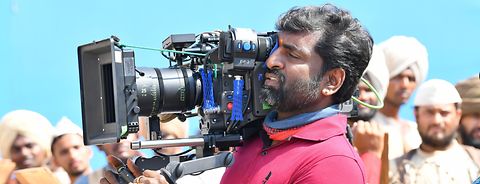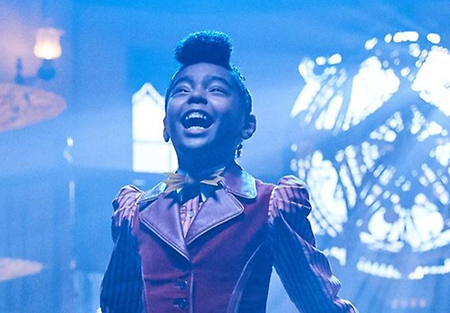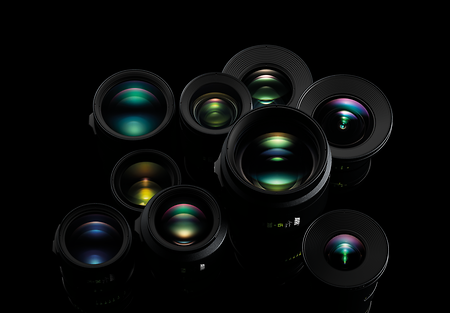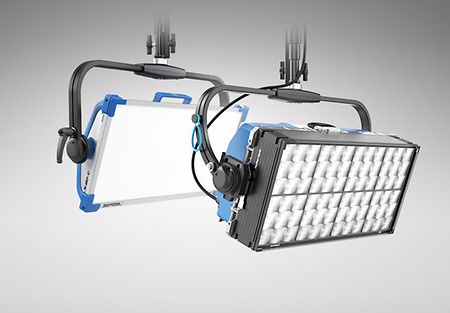Legendary director S.S. Rajamouli began his journey with the movie “RRR” by imagining what might have happened if two real-life Indian revolutionaries, Alluri Sitarama Raju and Komaram Bheem, had met and joined forces in the 1920s, during the time of the British Raj. This idea inspired a screenplay, co-written by Rajamouli, layered with concealed identities, anti-colonial insurrection, and explosive action. Produced on a lavish scale in studios and locations across India, Ukraine, and Bulgaria, “RRR” found a global audience and was awarded Best Original Song at the 95th Academy Awards. It was shot by cinematographer K.K. Senthil Kumar, who spoke to ARRI about how the ALEXA LF camera, Signature Prime lenses, and SkyPanel lights helped him craft an immersive look.
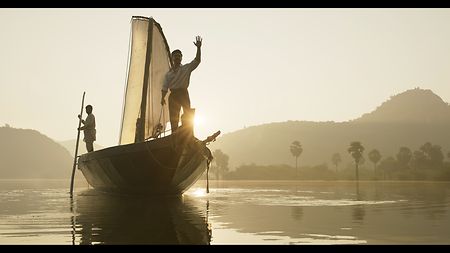
“RRR” won an Oscar® for Best Original Song ("Naatu Naatu") at the 95th Academy Awards
How did you select your cameras and lenses for this movie?
It is my job as a cinematographer to capture the vision of the director and bring it to life on screen. For “RRR,” I wanted to find the perfect camera and lens combination that would not only meet the technical requirements of the film, but also enhance its artistic expression. After testing various options, I was drawn to the ARRI ALEXA LF and Signature Prime lenses for their ability to beautifully render the wide landscapes and intense close-ups that were central to the film's dramatic narrative. The large-format sensor and 4.5K resolution of the ALEXA LF provided a stunningly sharp and naturalistic image, while the Signature Primes added a magical cinematic touch.
What benefits did large format bring?
The ALEXA LF, with its organic image quality and shallow depth of field, allowed me to bring the audience closer to the characters, to feel their struggles and sacrifices, and to experience the film in a more immersive and three-dimensional way. Large format gave me the space to tell the story in a way that was true to the spirit of the heroes depicted, and when we were simultaneously shooting for IMAX and CinemaScope, it helped me compose for both formats without sacrificing any of the impact or emotional depth of the film.
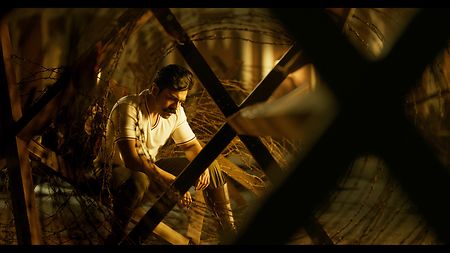
Earthy tones and muted colors contributed to the authentic historical feel
What kind of a look did you want to create for the film?
When crafting the visual style for “RRR,” I wanted to ensure that it was true to the time period of the 1920s. To achieve this, I delved deep into research on the photographic and artistic styles of that time, studying historical photographs and paintings, and movies set in that era. However, my biggest ambition was to create a cinematic look that was unique to the film, and not just a replication of the past. I utilized a warm, rich look that evoked the feeling of the Indian landscape and culture, employing a lot of earthy tones and muted colors to create a sense of authenticity and immersion in the historical setting.
I preferred natural or source-inspired lighting and also used period-accurate light fixtures and techniques to keep the sense of realism. I collaborated closely with the production designer and costume designer to establish a cohesive visual language throughout the film and used visual effects to enhance period-specific details. My ultimate goal was to give the audience an immersive experience, taking into account their visual expectations of the era.
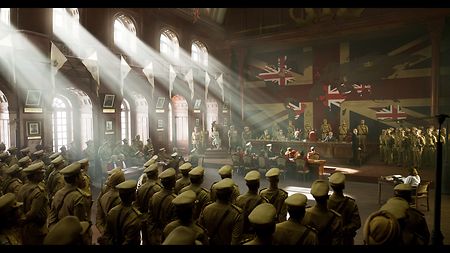
Dramatic but source-motivated lighting helped craft a strong look for the film
What was your experience of working with S.S. Rajamouli?
Collaborating with S.S. Rajamouli has been a challenging and fulfilling journey for me as a cinematographer. His vision granted me the time and freedom to craft high-quality and detail-oriented imagery for the film. His demanding work ethic motivates me to reach my full potential and create the best possible visuals. Keeping up with the latest technology helps me to fully support the film's success. Overall, working with Rajamouli has been a rewarding experience that has allowed me to grow and develop as a cinematographer.
How important was accurate color capture on this production?
Accurate color capture was extremely important, especially given the significant amount of VFX work involved. I was pleased with the results we achieved using the ALEXA LF camera and Signature Prime lenses. Before the shoot, we conducted camera tests to ensure that the colors would be accurately reproduced on screen, particularly in scenes involving fire and water. The reputation of ARRI's color science and color reproduction made the ALEXA LF a strong choice for this project, and the Signatures helped to elevate the overall quality of the images. In the end, the combination of these tools and techniques allowed me to capture accurate colors that enhanced the final product.
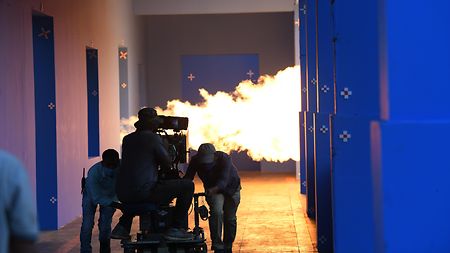
The ALEXA LF’s accurate color capture and high dynamic range made a big difference to scenes involving flames
What was your general approach to using the camera and lenses?
I prefer using a single camera for principal photography. Only when there’s a major action setpiece do I use more than one camera setup. Camera movement is a storytelling tool that helps get audiences involved in the film by heightening emotion, but I avoided over-stylized and unrealistic camera movement in favor of a more classical approach. I mostly shot at the native 800 ASA, sometimes going to 1280 or 1600 ASA when required, knowing I would get a clear image without noise in the shadow areas.
I used a wide range of Signature Prime focal lengths, from 18 mm up to 150 mm, depending on the requirements of the shot. My preferred stop was between T2.8 and T4 because it gave me an attractive depth of field without losing details in the background that emphasized the era. The performance of the lenses, and the dynamic range of the camera, really helped with high-contrast scenes, night scenes with fires, and low light situations.
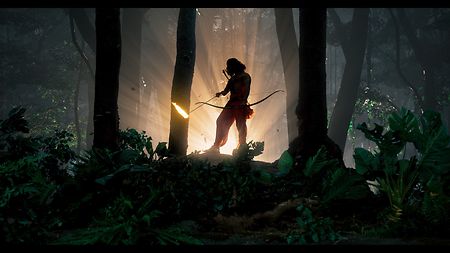
Low light and high contrast situations were handled by the combination of ALEXA LF with Signature Primes
How did you use ARRI SkyPanels and what do you like about them?
I am a big fan of soft light, so I was excited when ARRI came up with the SkyPanels. Before they appeared on the market, I would have to hang hundreds of 1K and 2K lights to create an evenly spread soft top light in a studio floor, skimming them three or four times to achieve the softness that we wanted. This would generate a lot of heat and there was always a chance of the skimmer cloth catching fire.
SkyPanels are customizable, can easily be connected via DMX, and heating isn’t an issue, so it’s easy on the actors. They’re simple to rig in studios and you can create all kinds of effects, like firelight, with custom settings. We used all the different SkyPanel models on this movie: the S30, S60, S120, and S360. The colour rending quality of these lights is good; we can easily change the color temperature or adjust the intensity through DMX without touching the light. It’s easy to create a large source of soft light with SkyPanels, and for blue/green matt lighting they’re very useful for creating soft diffused light that illuminates evenly.
What were your biggest challenges on the film, and what are you most proud of?
Our production was majorly affected by the COVID-19 pandemic, with the shoot extending across four years. We revisited so many scenes; the big challenge was to maintain continuity in the film. I always keep a camera report book with detailed notes of every shot we do in terms of the lighting setup, camera position and movement, exposure, and lens settings, which came in handy for this situation.
I am incredibly proud of the work that went into making “RRR” a memorable and impactful experience for audiences, not just in India but across the globe. To be recognized for my work by audiences, filmmakers, and critics is an honor that I will always cherish. The film’s award wins and nominations are a testament to the dedication of the entire cast and crew. I’m proud to have been part of a film that has put India center stage in the film world.
